<< DUPONT | Yonge-University-Spadina | ST. GEORGE >>
<< BATHURST | Bloor-Danforth | ST. GEORGE >>
<< Terminal | 510 SPADINA | QUEEN’S QUAY >>
Subway Related Properties Page
Text by James Bow
See Also
- VIDEO - Station Walkthrough, by Damian Baranowski.
Spadina station has grown considerably since it first opened, more than fifty years ago. It was launched as a local neighbourhood station in a sleepy part of the city, and it has transformed with the area and the city into a major transportation hub serving one of the most heavily used streetcar routes, and two subway routes.
Walmer Station
When the first designs of Spadina station appeared, it wasn’t even called Spadina. Instead, the first maps of the proposed BLOOR-DANFORTH subway showed a station in the area named Walmer instead, after the residential street located one block west of Spadina, running north from Bloor Street. Spadina Avenue was a major commercial street, boasting streetcar service along its length until 1948, but most of the ridership and commercial development south of Bloor.
Spadina Avenue itself ended at Bloor, and a more residential Spadina Road took over for a run from Bloor to Davenport. Even though the station name was soon changed to Spadina, suggesting some redesigning had occurred, only a pair of modest entrances were to be installed. Even though the 77 SPADINA was running past the station, there would be no bus loop within the station, and transfers would be required to change from bus to subway and vice versa.
A Second Subway
The first major change to Spadina station would occur over ten years after its opening, with the construction and launch of the SPADINA SUBWAY. The new line started from the UNIVERSITY SUBWAY platform and curved west and north to Spadina Avenue south of Lowther Avenue, before continuing its journey beneath the Nordheimer Ravine, Cedarvale Park and the median of the Spadina Expressway (today known as Allen Road) to Wilson Avenue. A station was planned just north of the Lowther/Spadina intersection, and it would likely have been another local neighbourhood, called “Lowther”, until the TTC decided to link the station with Spadina station further south and uniting the two stations under one name.
The reason for this change was because the UNIVERSITY SUBWAY was not operating after 9:30 p.m. on weekdays and Saturdays, or at all on Sundays and holidays, due to the line’s low ridership. The ridership of the SPADINA SUBWAY line was a big question mark, and if the line didn’t increase the UNIVERSITY line’s ridership enough to justify late evening and Sunday operation, there was a possibility that the SPADINA line might be operated separate from the YONGE SUBWAY at those times. A double crossover was installed north of Spadina station’s new north and southbound platforms for Wilson-Spadina operation, and an over 200 meter-long tunnel built to allow passengers to connect with the BLOOR-DANFORTH subway.
One wonders why SPADINA trains couldn’t continue to St. George, allowing transfers there. Yes, the curves and the interline track connections west of St. George station made installing a crossover impractical, but a crossover already existed east of St. George station. Changing ends there might be more complicated than at other TTC terminal stations, but not impossible.
Competing Architectural Aesthetics
Whatever the case, the question became academic, as the SPADINA SUBWAY increased ridership on the UNIVERSITY line that late evening and Sunday closures were never considered, and the SPADINA line never operated separately from the YONGE subway. The design change, however, did contribute to one of the station’s best-known features: a long moving walkway set up along the pedestrian tunnel easing the over 200 metre-long walk. Unfortunately the length of the walkway meant that it became difficult to maintain. By the late 1990s, breakdowns were common, and in the era of limited budgets, the TTC decided that the moving sidewalk was too expensive to maintain or replace. It was shut down for good and ultimately removed in 2004.
The SPADINA subway meant other changes for Spadina station. The original east-side entrance was removed, and a bus loop and terminal building was built in its place, acting as the main entrance to the station. The 77 SPADINA route was split to operate out of this terminal, with a new 103 SPADINA NORTH route established to handle bus service north of the station.
The new bus terminal, located across the street from the old west-side entrance to the station, highlight the different architectural aesthetics of 1966 and 1978. Whereas the older entrance is a metal and glass box, with clear modernist lines, the 1978 entrance and bus terminal features a pseudo-mansard roof and brick arches, with dark colours and little obvious signage. This difference is mirrored by the older and newer platforms, with the BLOOR-DANFORTH platforms showing the straight lines, lighter colours and simple tile patterns of the other stations on the line, while the SPADINA platforms have a unique tile pattern and darker colours and station signage. The stations of the SPADINA subway were built more in the style of the Montreal Metro, with each station having unique architecture and seventies-modern flourishes.
At the north end of the SPADINA SUBWAY platforms, a remarkable engineering and preservation project was incorporated into the new station entrance. A house at 85 Spadina Road, built in 1899 by architect Robert Ogilvie for lawyer Norman B. Gash, was listed as a heritage property by the City of Toronto when plans to build new Spadina station moved forward in 1974. The property had been slated for demolition as part of the proposed Spadina Expressway. Though the Spadina Expressway project had been cancelled in 1971, the Metropolitan government and the TTC acquired the building to demolish it for a station entrance. Protests from local residents forced the TTC to change its plans, repurposing the old building itself as the entrance.
The new Spadina station platforms were built during a period when the TTC incorporated more artwork into its new stations. A large mural called “Morning Glory” was commissioned. Made by Louis de Niverville, this enamel piece is found on the street level of the northern entrance to Spadina station, inside the old Gash house. A second piece, a quilt featuring caribou on tundra called “Barren Ground Caribou” by Joyce Wieland, can be found on the concourse level below.
But the original Spadina platforms are not without their own flourishes. Minimalist bus and subway designs were sandblasted next to the “SPADINA” station name on the tiles on the BLOOR-DANFORTH platform. These were installed in 1978, commemorating the opening of the new bus terminal at the station, and are the only such embellishment found on the station walls of the original BLOOR-DANFORTH subway stations, until renovations changed the appearance of Dufferin and Pape stations decades later.
Streetcars Arrive
When the SPADINA SUBWAY platforms opened on January 28, 1978, plans were underway to restore streetcar service to Spadina Avenue. The TTC acknowledged this by installing signs pointing to the connecting tunnel advertising “TO STREETCARS”, but it was a bit premature. Plans stalled through the 1980s and construction only began in the early 1990s. Patience was eventually rewarded, however, with the launch of the 510 SPADINA route in July 27, 1997.
The new streetcar route brought about another major change to Spadina station. An underground loop was built, which streetcars entered from Spadina Avenue just north of Sussex Avenue. The loading platform was built along what had been the southern wall of the concourse level, between the bus terminal and the BLOOR-DANFORTH subway platforms. Yet another style of station signage and tiling was used here.
But the streetcars also changed Spadina station in other ways. As an interchange station, it had always stood in the shadow of the more heavily used St. George and Bloor-Yonge stations. The new streetcars added crowds. Spadina station was becoming a major transportation hub serving not just the Annex neighbourhood, but the University of Toronto and, further south, Chinatown.
The construction related to the 510 SPADINA streetcar allowed the TTC to install elevators making the BLOOR-DANFORTH platforms of Spadina station wheelchair accessible, but this change didn’t include the SPADINA subway platforms. The configuration of the station there makes the installation of elevators problematic. No elevators have been installed at the Lowther Avenue entrance.
The last major change to Spadina station added a third entrance, this one located at the western end of the BLOOR-DANFORTH platforms, updating the station to current fire codes (although without elevators, making the entrance inaccessible to wheelchairs). The stairs from the west end of these platforms leads to a glass and metal automatic entrance building located on the east side of Walmer Road. Construction on this entrance began in 1998, and proved more difficult to complete than expected. After more than eighteen months, during which time local residents complained of excessive noise and disruption, the new entrance building opened to the public in late January 2001.
A Patchwork Quilt
The changes to Spadina station make it one of the largest on the TTC network by area. From the Walmer Road entrance through the BLOOR-DANFORTH subway platforms, the connecting tunnel, the SPADINA SUBWAY platforms and to the Lowther exit, it’s possible to walk over half a kilometre through the fare-paid area of the station. The many changes that have occurred to the station throughout its fifty year history has produced a patchwork quilt of architectural styles and configurations. The station is partly accessible, and in many ways an accidental interchange. However, the crowds show how important the station is, both for the local neighbourhood and the wider network.
Service Notes (as of November 26, 2017):
- Off-Site Resources:
- The official TTC Spadina Page
- Spadina Station on Wikipedia
- VIDEO - Station Walkthrough, by Damian Baranowski.
- Line: 1 Yonge - University - Spadina
2 Bloor - Danforth - Hours of Operation:
First Train to Vaughan: 6:12 a.m. weekdays, 6:18 a.m. Saturdays/holidays, 8:23 a.m. Sundays.
First Train to Union/Finch: 6:00 a.m. weekdays, 6:01 a.m. Saturdays/holidays, 7:56 a.m. Sundays.
First Train to Kennedy: 6:01 a.m. weekdays, 6:08 a.m. Saturdays/holidays, 8:23 a.m. Sundays.
First Train to Kipling: 5:58 a.m. weekdays, 6:03 a.m. Saturdays/holidays, 8:12 a.m. Sundays.
Last Train to Vaughan: 2:01 a.m. weekdays, 1:57 a.m. weekends/holidays.
Last Train to Union/Finch: 1:35 a.m.
Last Train to Kennedy: 1:51 a.m.
Last Train to Kipling: 1:55 a.m. - Address: 6 Spadina Road
- Opened: February 25, 1966
- Wheelchair Accessible Since: 1997 (Bloor-Danforth platform only; people with accessibility needs transferring to the Spadina subway should do so at St. George station)
- Average Weekday Ridership:
13,790 (Yonge-University), 33,210 (Bloor-Danforth) (2015)
14,680 (Yonge-University), 38,550 (Bloor-Danforth) (2014)
13,670 (Yonge-University), 35,120 (Bloor-Danforth) (2013)
13,500 (Yonge-University), 41,130 (Bloor-Danforth) (2012)
13,410 (Yonge-University), 35,730 (Bloor-Danforth) (2011)
13,040 (Yonge-University), 35,010 (Bloor-Danforth) (2010)
14,910 (Yonge-University), 35,810 (Bloor-Danforth) (2009)
12,370 (Yonge-University), 35,200 (Bloor-Danforth) (2008) - Entrances:
- Spadina Road, east side entrance, accessible, located on Spadina Road 60 metres north of Bloor Street.
- Spadina Road, west side entrance, automatic, non-accessible, located on Spadina Road, 55 metres north of Bloor Street.
- Walmer Road, automatic, non-accessible, leading to Bloor-Danforth subway platforms, located on east side of Walmer Road, 60 metres north of Bloor Street.
- 85 Spadina Road, automatic, non-accessible, leading to Spadina subway platforms, located on the east side of Spadina road, 149 metres north of Lowther Avenue.
- Kendal Avenue, automatic, non-accessible, staircase leading from sidewalk on north side of Kendal Avenue at Spadina Road leading to Spadina subway platforms.
- Elevators (click here for maintenance schedule):
- Concourse to eastbound Bloor-Danforth subway platform
- Concourse to westbound Bloor-Danforth subway platform
- Street level to Concourse (Spadina Road, east side entrance)
- Escalators (click here for maintenance schedule):
- Southbound Platform To South Concourse Spadina (YUS) (Up At All Times)
- Southbound Platform To South Concourse Of Spadina (YUS) (Down At All Times)
- Northbound Platform To South Concourse Of Spadina (YUS) (Up At All Times)
- Northbound Platform To South Concourse Of Spadina (YUS) (Down At All Times)
- Concourse To Street - West Side Of Spadina (Up At All Times)
- Eastbound Platform To Concourse (Up At All Times)
- Westbound Platform To Concourse (Up At All Times)
- Concourse To Bus Bay (Down At All Times)
- Concourse To Bus Bay (Up At All Times)
- Forms of fare payment include Presto, credit or debit
- Cellular and wi-fi enabled
- Pass Vending Machine available.
- Side platforms (both lines)
- Token vending machines
TTC Surface Connections:
- 127 DAVENPORT
- 300 BLOOR-DANFORTH (Transfer Required)
- 510 SPADINA
Former TTC Surface Connections:
Spadina Station Image Archive

|
A view of the east-side entrance to Spadina Station circa 1975, set back from Spadina Road by several metres to make room for the anticipated widening as a result of an extension of the Spadina subway that didn't happen. This photo is courtesy the Toronto Archives and Nathan Ng's Station Fixation website. |

|
Louis Swanson snapped this picture of the original entrance to Spadina station, on the west side of Spadina Road north of Bloor Street. This shot was taken around October 1975 and is courtesy the John Knight collection. |

|
A view of the mezzanine level of Spadina staton, looking towards the stairs to the eastbound platform. This view shows the fare gates that were located here before being moved into the new station entrance building a few months later. This photo was taken for the Toronto Archives and is courtesy Nathan Ng's Station Fixation website. |

|
A view of the mezzanine level of Spadina Station, taken for the Toronto Archives on January 26, 1976. This view is very different from today. It looks west towards the stairs leading to the eastbound platform, and the passageway to the west-side entrance from Spadina Road. This image is courtesy Nathan Ng's Station Fixation page. |

|
A view of the mezzanine level of Spadina station, looking to the right of the previous shot. This shot, taken for the Toronto Archives on January 26, 1976, looks west towards the fare gates and the stairs leading to the westbound platform. This shot is courtesy Nathan Ng's Station Fixation page. |

|
A view of the mezzanine level of Spadina station, looking southeast to the non-fare-paid area. Signs on the right point to the west-side entrance from Spadina Road, while the other signs point to the east-side entrance. This shot was taken for the Toronto Archives on January 26, 1976, and is courtesy Nathan Ng's Station Fixation site. |
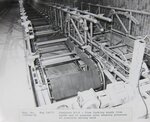
|
A close-up of the workings of the moving walkway built into the passageway between the Spadina and Bloor-Danforth platforms of Spadina station. This photo was taken for the Toronto Archives on May 18, 1977 and is courtesy Nathan Ng's Station Fixation website. |

|
A close-up of the workings of the moving walkway in the passageway between the Spadina and Bloor-Danforth platforms at Spadina station, looking north. This shot was taken for the Toronto Archives on June 9, 1977 and is courtesy Nathan Ng's Station Fixation website. |

|
A view of the moving walkway under construction between the Spadina and Bloor-Danforth subway platforms at Spadina station. This view is looking north and was taken for the Toronto Archives on October 13, 1977. This image is courtesy Nathan Ng's Station Fixation site. |

|
On November 1, 1977, the new bus transfer facility at Spadina station opened to the public. This photo was taken for the Toronto Archives and is courtesy Nathan Ng's Station Fixation website. |

|
Another view of the newly-opened entranceway and bus terminal at Spadina station was taken for the Toronto Archives on the afternoon of November 1, 1977. This image is courtesy Nathan Ng's Station Fixation website. |
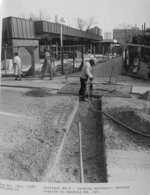
|
A view of road construction work at the bus terminal at Spadina Station. This photo was taken for the Toronto Archives on November 1, 1977 and is courtesy Nathan Ng's Station Fixation website. |
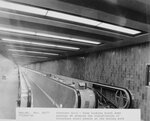
|
A view of the moving sidewalk, looking south from the Spadina subway platform, taken for the Toronto Archives on December 16, 1977. This image is courtesy Nathan Ng's Station Fixation website. |

|
An announcement of the opening of the Spadina subway, placed in the Toronto Star on January 25, 1978. This image is courtesy Nathan Ng's Station Fixation website. |
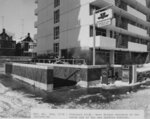
|
A view of the street entrance to Spadina subway station off of the northwest corner of Spadina Road and Kendal, taken for the Toronto Archives on February 7, 1978. This image is courtesy Nathan Ng's Station Fixation website. |

|
A view of the pillars and ceiling arrangement in the mezzanine level between the Bloor-Danforth and Spadina subway platforms at Spadina Station. This photo was taken for the Toronto Archives on January 11, 1982 and is courtesy Nathan Ng's Station Fixation website. |

|
A rendering of Spadina station's streetcar platform, made by the provincial government in the mid 1990s. |

|
The mezzanine level of Spadina station, looking from the stairway to the westbound platform towards the streetcar loading area. This photograph was taken by Richard White on February 5, 2011. |

|
The west-side Spadina Road entrance to Spadina station is an automatic entrance, but a collector's booth exists if needed. This photo was taken by Richard White on February 5, 2011. |

|
After entering the automatic entrance off the west side of Spadina Road, passengers head downstairs towards the mezzanine level of Spadina station. This photo was taken by Richard White on February 5, 2011. |
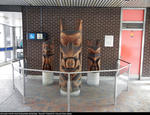
|
These K'San Village House Posts were carved by Gitksan artists from Hazelton, BC. These were commissioned in 1979 by the Wigwamen Housing Corporation to commemorate the building of Wigwamen Terrace at 14 Spadina Road. These posts were carved out of red cedar, depicting an owl, a wolf and a hawk. Fedelia O'Brien carved the owl, Murphy Green carved the wolf and Chuck Heir carved the hawk. These can be seen at the eastern side of the Spadina station main entrance. This photo was taken by Richard White on February 5, 2011. |

|
The main entrance to Spadina subway station, looking west from inside. This photo was taken by Richard White on February 5, 2011. |

|
The entrance to Spadina station from Walmer Road, taken by Richard White on February 5, 2011. |

|
The concourse leading from the Walmer Road entrance to Spadina station to Spadina's subway platforms, taken by Richard White on February 5, 2011. |

|
Here, we see the main entrance to Spadina station, located on the east side of Spadina Road, just north of Bloor Street. From 1978 to 1997, this terminal played host to the 77 SPADINA bus route, as well as less-frequent services heading to the north. Today, only the 127 DAVENPORT stops here. The 510 SPADINA loads below. The 70s architecture of this building is clear. This image was taken by Secondarywaltz on January 20, 2012 and is used in accordance with his Creative Commons License. |

|
The Spadina station westbound platform sees crowds during the afternoon rush hour of April 7, 2016. Photo by James Bow. |

|
The Spadina station automatic entrance building off the east side of Walmer Road. This photo was taken by James Bow on April 7, 2016. |
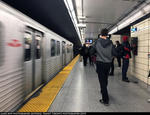
|
Passengers gather as a westbound train enters Spadina station on the evening of February 2, 2017. This photograph was taken by James Bow. |
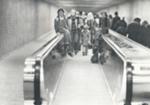
|
Teens ride the Spadina station moving sidewalk, likely in a manner TTC personnel or their parents would not have approved of, soon after the SPADINA line opened in 1978. This photograph was by Chris McConnell of the Toronto Star and is courtesy the Toronto Public Library. |

|
An H1 train heads southbound into the newly opened Spadina subway platform of Spadina station on January 28, 1978. This photograph was taken by Robert McMann and is courtesy the Damian Baranowski collection. |

|
The Spadina station mezzanine. A mess of styles and a significant transit hub. This 2000 photograph is by David Cavlovic. |

|
The long connection between the Bloor-Danforth subway and the Spadina subway at Spadina station, with moving sidewalk, as seen in the year 2000. The elevator on the right was added since the connection was built, and the moving sidewalk has since been removed. Photo by David Cavlovic. |

|
The Norman B. Gash House entrance to Spadina's subway station on the east side of Spadina Avenue near Kendal. This photograph was taken by Secondarywaltz on January 20, 2012 and is used in accordance with his Creative Commons License. |

|
Tile artwork adorns the wall beside the passageway leading from the main concourse level to the Spadina subway Spadina station platform. This photo was taken by James Bow on January 19, 2017. |

|
A brother and sister head into the connecting tunnel from the main concourse to Spadina station's Spadina subway platforms on the morning of January 19, 2017. Photo by James Bow. |

|
At the northern end of the connecting passageway, a passenger hears an arriving train and hurries onward. This photograph was taken by James Bow on the morning of January 19, 2017. |

|
The automatic fare gates at the northern entrance to Spadina station, seen from the northbound stairs. This photo was taken by James Bow on the morning of January 19, 2017. |

|
A view of Spadina station's automatic fare gates at the northern entrance to the station and the art piece Barren Ground Caribou, taken from the stairs to the southbound platform by James Bow on the morning of January 19, 2017. |

|
A Toronto Rocket train pulls into the northbound platform of Spadina station on the morning of January 19, 2017. Photo by James Bow. |

|
Barren Ground Caribou, by Joyce Wieland, commissioned in 1978, can be found at the Lowther exit of Spadina subway station. This photograph was taken in January 2007 by Gniw, and is used in accordance with their Creative Commons License. |
Next in Line
<< DUPONT | Yonge-University-Spadina | ST. GEORGE >>
<< BATHURST | Bloor-Danforth | ST. GEORGE >>
<< Terminal | 510 SPADINA | QUEEN’S QUAY >>
Subway Related Properties Page

